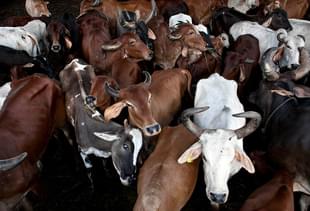Economy
Everything You Wanted To Know About New Livestock Sales Rules But Were Too Embarrassed To Ask
Hariprasad
May 30, 2017, 12:18 PM | Updated 12:18 PM IST
Save & read from anywhere!
Bookmark stories for easy access on any device or the Swarajya app.


In 2014, a Public Interest Litigation (PIL) was filed in the Supreme Court by animal rights activist Gauri Maulekhi asking the Court to direct the Government of India and various border states of India to take steps to prevent illegal trafficking of cattle to Nepal. Large scale trafficking of cattle to Nepal was taking place for sacrifice as part of the Gadhimai Festival held annually.
The Supreme Court heard the matter over nearly two years and passed several orders. The core of the matter, with a nudge from the two-judge-bench, was to be settled through an agreement between the Central government and the governments of the states of Bihar, West Bengal, Uttar Pradesh, Haryana, Rajasthan, Tripura, Andhra Pradesh, Orissa and Arunachal Pradesh.
With the Supreme Court’s direction and approval, a committee was setup under the chairmanship of Banshi Dhar Sharma, DG, Sahastra Seema Bal and a report with steps to address this problem was submitted to the court. The Supreme Court accepted this report and directed the Central government and state government to take steps towards compliance.
This order was passed on 13 July 2015.
Each state government, in addition to several other steps, had to do the following:
Constitute a district SPCA, within four weeks
- Constitute Animal Welfare Boards, within four weeks
- Submit a compliance report to the Court, within eight weeks
As part of the same committee report, accepted by the Court, the Central Government had to frame rules under Section 38 of the Prevention of Cruelty to Animals Act, 1960, specifically to ensure reduction in cruelty to animals in livestock markets, sale, etc.
On the 4 July 2016, the Supreme Court passed an order confirming the receipt of compliance reports by all concerned states. The bench noted that the Centre had not yet complied with its direction to frame and notify rules.
The Government of India responded that it is bound to frame the rules as per the directions of the Court, and would do so soon. The matter was posted for 12 July 2016.
On the 12 July 2016, the Supreme Court disposed of the case under the following directions.
- The Central government, which had informed the court that draft rules were almost ready, should finalise the rules ‘within three months’.
- The Central government would convene meetings between itself and the various stakeholder states to arrive at a comprehensive future plan to resolve this problem.
Notification of Regulation of Livestock Market Rules:
As per the orders of the Supreme Court, as highlighted above, the Government of India framed the rules for governing livestock markets, placed it for review and feedback, and in the end notified the rules (with finalisation based on feedback inputs) on the 23 May 2017.
Aim of notification:
Based on the SSB led Committee report submitted to the Supreme Court, and the directions of the Court, the Government of India decided to modify the structure of the sale of livestock.
“The livestock markets are intended to become hubs for trade for animal for agriculture through this process and animal for slaughter will have to be bought from the farmers at the farms”The official press release by the Government of India.
To obtain better control over the whole process of cattle trade, the following two decisions have been taken.
- Livestock markets will now be dedicated for trading of animals for agriculture.
- Animal purchases for slaughter will have to happen from farmers directly
Some key Questions
This piece was first published on Secure Core and has been republished here with permission.




